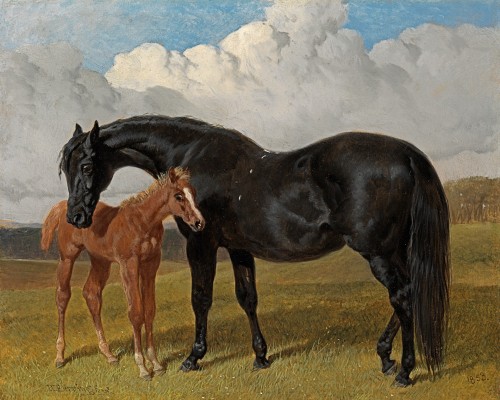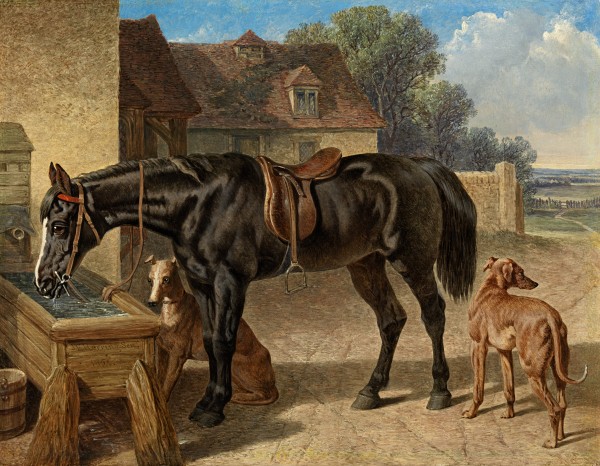JOHN FREDERICK HERRING SNR
Surrey 1795 - 1865 Meopham Park, Kent
Ref: CC 110
A mare and a foal in a landscape
Signed lower left: J.F. Herring. Senr.; dated lower right: 1853
Oil on panel: 9 ¾ x 12 in / 24.8 x 30.5 cm
Frame size: 16 x 18 ½ in / 40.6 x 47 cm
In its original nineteenth century fluted and gilded composition frame
Engraved:
As part of the series The Mothers, 1854-55
Provenance:
Christie’s London, 22nd November 2006, lot 109;
private collection, UK
Although he first became renowned as a sporting artist, in his later career John Frederick Herring Snr. was also a very fine painter of domestic animal scenes, in keeping with the development of Victorian taste towards an idealised appreciation of rural life. In 1853, when he was fifty-eight, he moved from Camberwell in south-east London to Meopham Park near Tonbridge in Kent, a Georgian house in thirty acres. It had ‘walled kitchen gardens, pleasure grounds, a five-acre orchard, lodge, granaries, brewing-house, farm-yard, piggeries, cow houses…and a room to paint in, 21 ft square…all for £180 a year’[1]. The Meopham years proved to be the most prosperous period of Herring’s career: ‘he had only to send a letter to London, saying that he had something to show, and “down would come the dealers and clear the deck” ’[2].
An acute observer of horse anatomy and behaviour, Herring captures the tender bond between the black mare and her chestnut foal in this painting. It was engraved as part of a series of nine prints entitled The Mothers in 1854-55, published in the Art Journal. The series featured four different types of horse, as well cows, ducks and pigs with their offspring, appealing to Victorian sentiment and the British love of animals. Prints after his work allowed Herring to reach a wide public.
JOHN FREDERICK HERRING, Senior
Surrey 1795 - 1865 Meopham Park, Kent
John Frederick Herring was the son of a London merchant of Dutch parentage, who had been born in America. The first eighteen years of his life were spent in London, where his greatest interests were drawing and horses. In 1814 he moved to Doncaster, arriving just in time to see the Duke of Hamilton’s William win the St Leger. By 1815 he had married Ann Harris; his sons John Frederick Herring Junior, Charles and Benjamin were all to become artists, while his daughters Ann and Emma both married painters.
In Doncaster, Herring earned his living as a painter of coach insignia and inn signs and his contact with a firm owned by a Mr Wood led to his subsequent employment as a night coach driver. His spare time was spent painting portraits of horses for inn parlours and he became known as the ‘artist coachman’. Herring’s talent was quickly recognised and he soon found himself painting hunters and racehorses for the gentry.
In 1830, Herring left Doncaster for Newmarket, where he spent three years before moving to London. During this time, he may have received tuition from Abraham Cooper. In London, Herring got into financial difficulties and was rescued by W T Copeland, who commissioned many paintings including designs used for Copeland Spode bone china. In 1840-41, Herring visited Paris by invitation of the Duc d’Orleans, for whom he painted several pictures. In 1845, Herring was appointed Animal Painter to HRH the Duchess of Kent, followed by a commission from Queen Victoria, who was to remain a patron for the rest of his life.
Herring spent the last twelve years of his life at Meopham Park near Tonbridge, where he lived as a country squire. He now broadened his subject matter and painted agricultural scenes and narrative pictures, as well as his better known works of hunting, racing and shooting. A highly successful and prolific artist, Herring ranks with Sir Edwin Landseer as one of the most eminent animal painters of the mid nineteenth century. His paintings were very popular and many were engraved, including his thirty-three winners of the St Leger and his twenty-one winners of the Derby. Herring exhibited at the Royal Academy 1818-65, the British Institution 1830-65 and the Society of British Artists (whose Vice-President he became in 1842), 1836-52.
[1] Oliver Beckett, J.F. Herring & Sons, London and New York 1981, p.59.
[2] Beckett, op. cit., p.60.
























